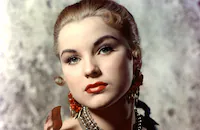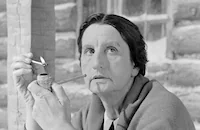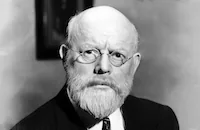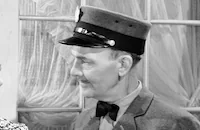There is no coincidence at all, however, between the similarities of this King Lear-inspired story and Broken Lance (1954), with Spencer Tracy as an 1880s Arizona ranch patriarch and Robert Wagner, Richard Widmark, Hugh O'Brian and Earl Holliman as his sons. Richard Murphy based his screenplay for the Western on the House of Strangers screenplay credited to Philip Yordan ( Detective Story, 1951; Johnny Guitar, 1954; El Cid, 1961). Yordan ended up winning the Academy Award for Best Writing, Motion Picture Story for the Tracy picture.
There's a certain irony to Yordan's win for a production in which he had no direct involvement and a story based on an earlier screenplay whose authorship has been a matter of dispute. Producer Sol C. Siegel hired Yordan to adapt Jerome Weidman's 1941 novel I'll Never Go There Any More with instructions to expand the role of the favored son, Max, who was not prominent in the original story. (Siegel likely had Yordan tame down or eliminate some of the source material's seamier and highly censorable elements.) According to Kenneth L. Geist's biography, Pictures Will Talk, about the film's director, Joseph L. Mankiewicz, Yordan was fired after submitting three-quarters of the script, and Siegel had Mankiewicz reshape the story and redo all the dialogue. The Screen Writers Guild ruled Yordan receive sole story credit and that Yordan and Mankiewicz should share credit for the screenplay. Considering it his sole work, Mankiewicz refused to share credit and subsequently received none at all.
The Italian-ness of the story, setting and characters caused concern, just as it would years later for The Godfather. Production Code Director Joseph Breen wrote to MPAA head Eric Johnston shortly before principle photography began in December 1948: "In view of the great number of protests which, I understand, you are receiving at the present time, against the alleged unfavorable portrayals of Italians and Italian-Americans in motion pictures, I desire to direct your particular attention to a script which has been received from the Twentieth Century-Fox Corporation, carrying the title 'East Side Story' [the film's working title]. Almost all the characters in the story are either Italians or Italian-Americans, who, when they are not characterized as definitely reprehensible people, are, at least, unsympathetic.... We have no way under the Code to correct this. It occurs to us that this picture, because of these Italian characteristics, may suggest a question of industry policy and, in accordance with our long-established procedure, we are referring this question to you." Obviously, nothing was done to soften the depictions or their connections to Italian ethnicity, and the extensive location shooting took place in New York's Little Italy.
In any case, the film was well received, with Bosley Crowther in the New York Times calling it "a sizzling and picturesque exposure of a segment of nouveau-riche life within the Italian-American population." At the Cannes Film Festival, Edward G. Robinson won Best Actor and Mankiewicz was nominated for the Grand Prix.
The storyline got yet another reworking in the circus drama The Big Show (1961), starring Cliff Robertson, Esther Williams and Nehemiah Persoff in the Conte, Hayward and Robinson roles. Yordan and Weidman, however, did not receive any credit on that production.
The film was shot by cinematographer Milton Krasner, an Oscar winner for Three Coins in the Fountain (1954) and known for All About Eve (1950) and Fritz Lang's noir dramas The Woman in the Window (1944) and Scarlet Street (1945), both of which starred Robinson.
Director: Joseph L. Mankiewicz
Producer: Sol C. Siegel
Screenplay: Philip Yordan, from a novel by Jerome Weidman
Cinematography: Milton Krasner
Editing: Harmon Jones
Art Direction: George W. Davis, Lyle Wheeler
Music: Daniele Amfitheatrof
Cast: Edward G. Robinson (Gino Monetti), Susan Hayward (Irene Bennett), Richard Conte (Max Monetti), Luther Adler (Joe Monetti), Paul Valentine (Pietro Monetti), Efrem Zimbalist Jr. (Tony Monetti)
By Rob Nixon

































